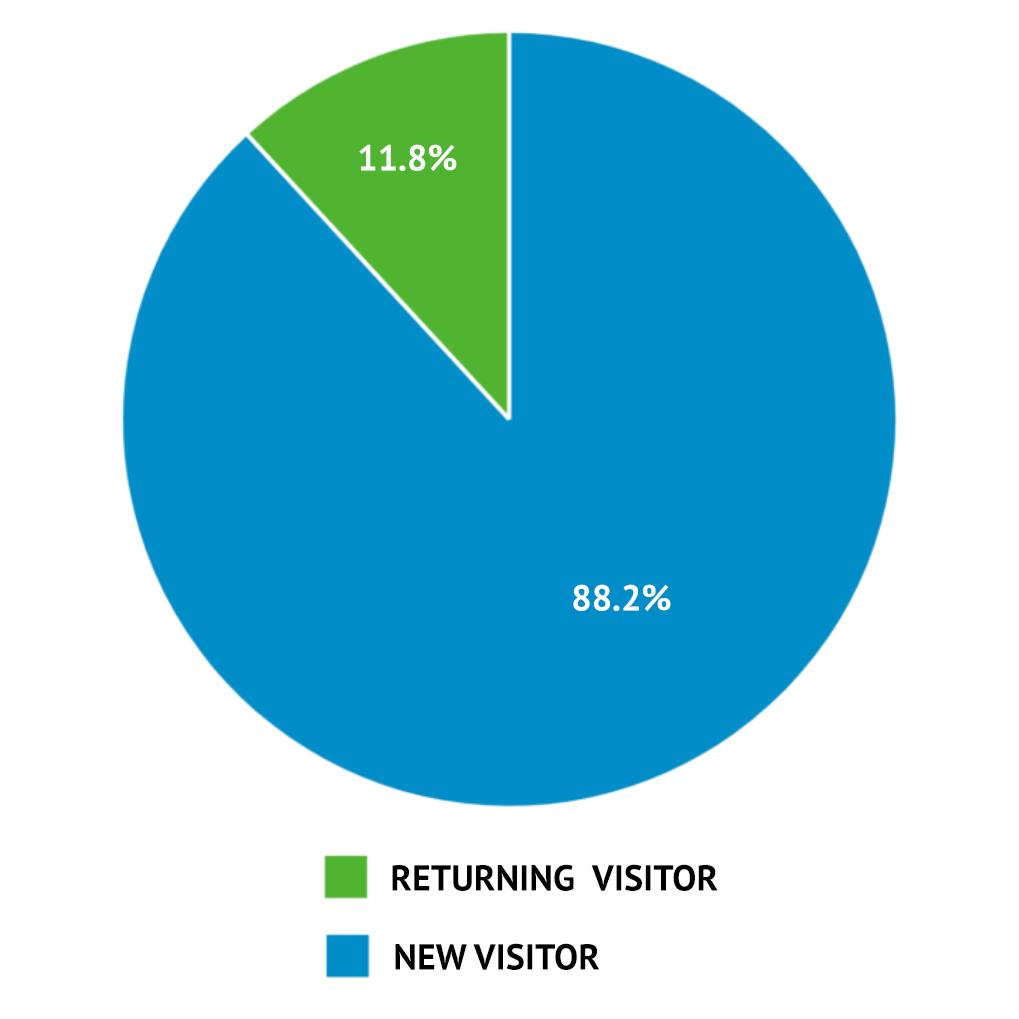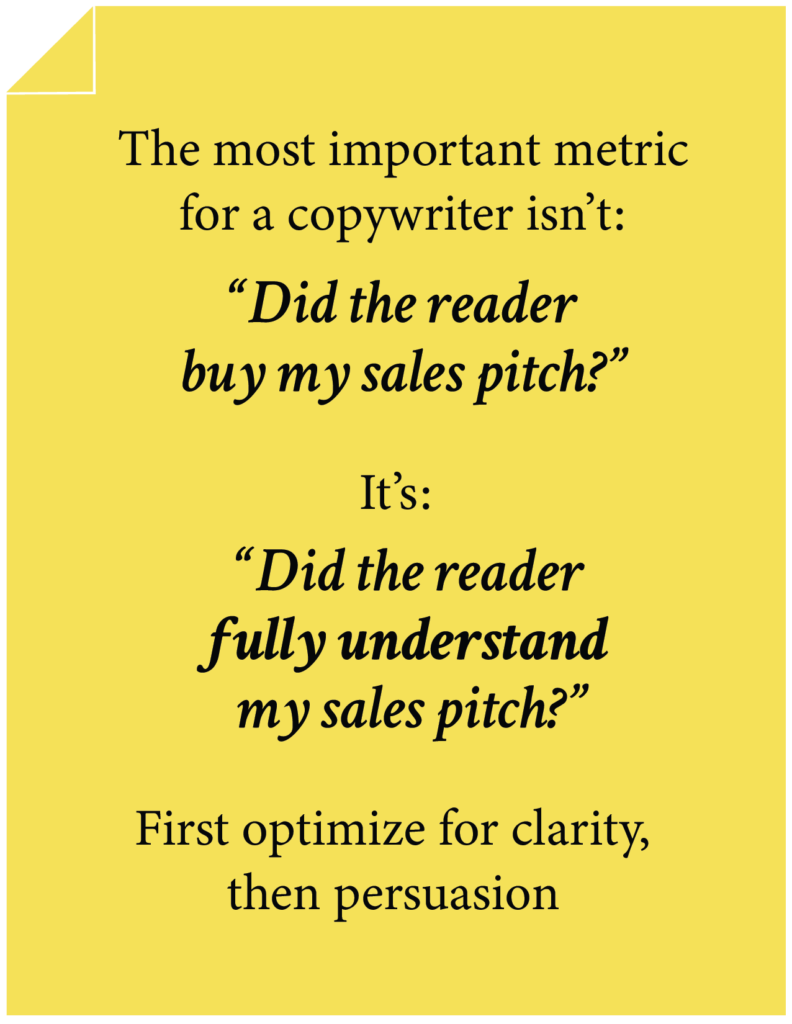Blog
Conversion Optimization Marketing
Marketing and conversion optimization are two coins on the same coin– one doesn’t make sense without the other.
Here is the partnership– marketing makes a promise and brings in new visitors, and conversion optimization converts those visitors into buyers.
How The Shopper Journey Relates to Conversion Optimization Marketing
New visitors that enter via marketing messages are promiscous– they aren’t just considering you, they are considering many other alternatives (including doing nothing.)
To convert these people conversion optimization needs to be perfectly fine-tuned. There is no room for error.
We Got One Shot
If you go to your Google Analytics and peek into the Audience –> Overview report you’ll find a pie chart that shows your site’s returning visitor rate.
Here’s mine:

Even if your return rate is 20% it means 80% of visitors see your site just once.
Those are garbage odds.
What complicates matters is that even the visitors who stick around don’t stay long enough. Wolfgang Digital analyzed 130 million website sessions, over €330 million in online revenue, and calculated the average session duration (time on site) for all of eCommerce at 2 minutes and 32 seconds (source).
This means that not only do we need to close the sale on the first visit, but we also need to close it fast ⏱️.
How Conversion Optimization and Marketing Can Be Best Friends
I’m now going to show you how marketing and conversion optimization can become best friends. To fully extract conversion juice the marketer needs to do the following—
First, Shake Visitor Into Attention
We’ve already seen that ad traffic is in a promiscuous state. They’re also not giving us their full attention.
So, near the top of the sales pitch hint that our solution is better (which it is) than the four open competitor tabs. We’re vulnerable as long as those tabs live.
For a subtle hint we like this opening line:
Juicers aren’t created equal.
Replace [Juicers] with your product category.
This injects doubt into the shopper’s mind and lets her know to be careful in her consideration. It also cleverly incentivizes her to continue reading since now we’ve aroused her curiosity to understand why [juicers] aren’t created equal.
Was this section about opening line strategy clear? /
Glad that makes sense.
Uh oh! Let's get in touch so I can explain this better...
We'll talk soon!
Then, Seduce With Your Sales Pitch
This is when the marketer applies her copywriting magic to optimize conversion rates.
When we say copywriting we’re not talking about grammar and sentence structure— we’re talking about buyer psychology.
Shoppers are exposed to an uncomfortable number of ads every 24 hours. It’s not humanly possible for them to evaluate the merits of each marketing pitch they encounter. As a result, our brains have developed mental shortcuts to navigate this neon maze.
Over the course of 100s of A/B tests, we’ve identified nine mental checklist items shoppers’ brains use to evaluate the merits of a marketing pitch.
Your sales pitch needs to be constructed to satisfy these nine checklist items.
Here is a quick summary:
Your sales pitch needs to be believable, must demonstrate expertise, be impactful, give the buyer a reason to stop doing what they are currently doing and hire your solution, must feel special, and finally, your sales pitch must address objections.
This is explained in great detail in the article in the Further Reading section at the bottom of this post. My advice is to read that article after completing this one.
Next, Create Paths For Diggers
Your site is visited by two types of buyers— Skimmers and Diggers.
Skimmers like quick and to-the-point content.
Diggers want the opposite— they crave detail.
To optimize conversion rates we need to talk to both Skimmers and Diggers.
Here is how to tackle that. By default write content for Skimmers. So when the page loads the visitor is seeing short and sweet content.
At strategic locations across the page add prompts so Diggers can get to more detailed explanations. We link to an article about Skimmers and Diggers in the Further Reading section below.
And Finally, Add Markers So We Know if the Main Parts of the Sales Pitch Are Working
Before expecting visitors to pull out their 💳 we need to know if they fully understood our sales pitch.

If any section is unclear the flow will be broken and the visitor will exit.
I need to know the exact location where the reading flow was disrupted so I can rewrite that section. We have a simpleclever solution for this.
Here’s what we do— after each important section we add Clear and Unclear buttons (you’ll need to look closely to see them in the screenshot below):

If people click Clear or Unclear you can show a message like: Thanks for your feedback.
In the back-end store those responses. Now you can look at the relative number of Clear or Unclear clicks. If it’s 80% Clear your copy is clear. If it’s 50% Clear that section needs TLC.
Was this section about Clear/Unclear buttons clear? /
Thank you for your feedback. You are the best.
Uh oh! Let's get in touch so I can explain this better...
We'll talk soon!
Further Reading
We hope you liked this conversion optimization marketing article. It was intentionally kept high level. We didn’t want to include too many links in the article and risk breaking your attention.
This article introduced a new concept of Skimmers and Diggers. To learn about these two shopper types head over to this article: Tell Me More About Skimmers and Diggers.
The closing of the article talks about the nine mental checklist items shoppers use. To dig into that content please read our sales pitch construction kit article.
The article also talks about a PillowCube.com case study. You can read all about that here.
After digesting the conversion copywriting article you’ll want to know the actual step-by-step process to infuse this new content into your product pages. That’s explained here: Infusing Your Product Story To Your Product Page.
About Frictionless Commerce
We deliver an unfair advantage to technical product DTC brands (for example, Dyson) by improving advertising effectiveness by 20% in 90 days. This is achieved using a buyer psychology conversion copywriting framework. All paid traffic eventually reaches the product page and this is where we strike. Our process.
If you like doing the hard work yourself, our founder Rishi shares conversion ideas on LinkedIn every day. Connect with him here.
If you want to make your life easier and still increase conversions, jump on a call.



